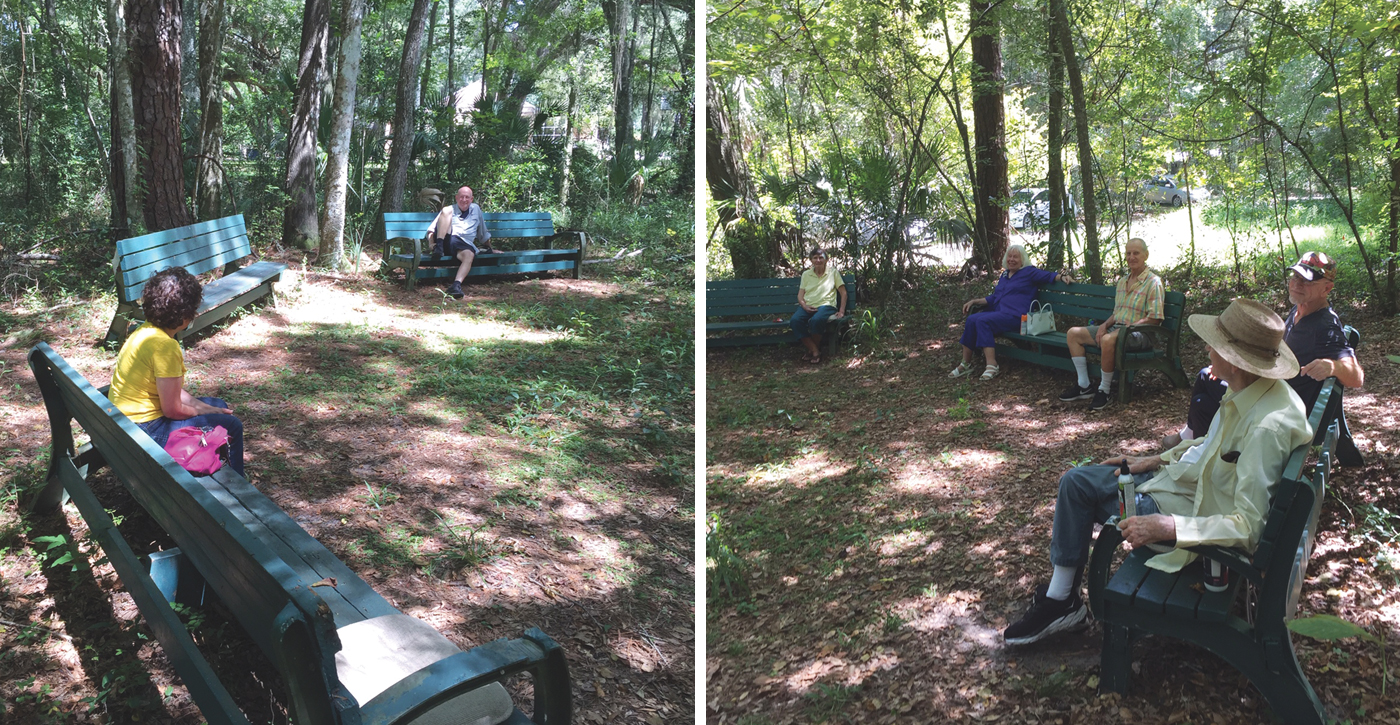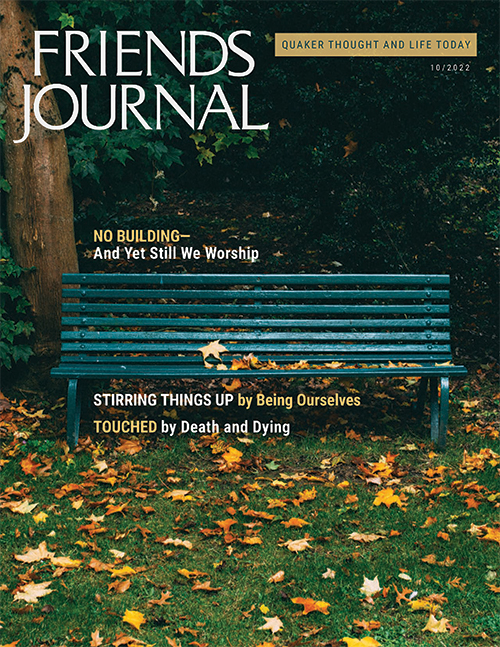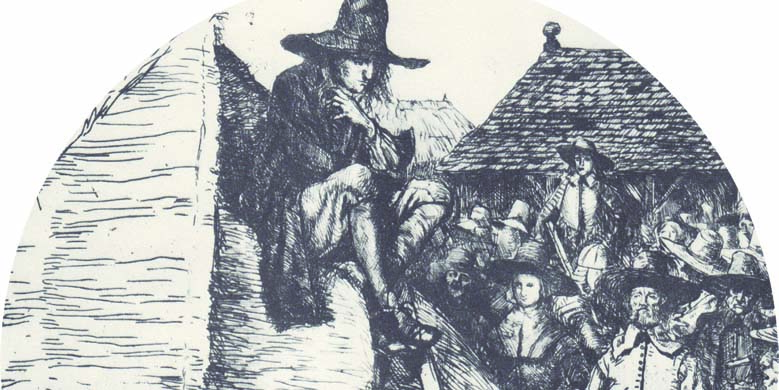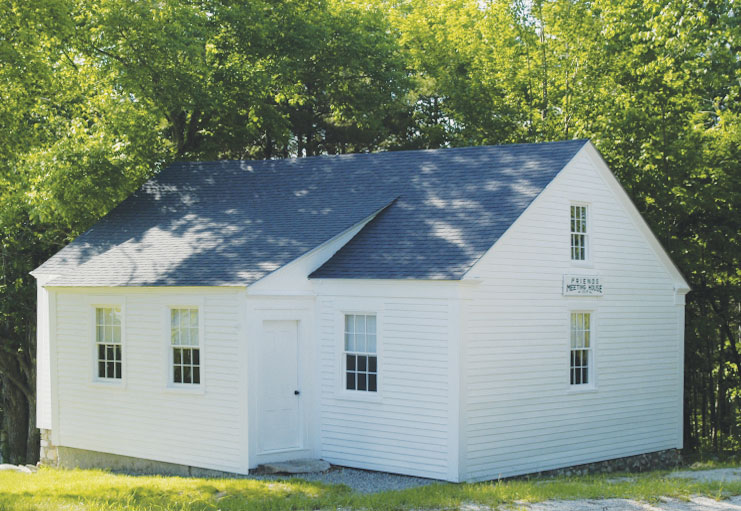From the time I was little, I have only ever gone to church in a building. In my earliest days, it was a small, stone Episcopal chapel with a modest altar and dark, carved pews. In summer, the vicar offered woven palm-frond fans to help stave off the worst of the New England heat.
As a young wife and mother, my family and I joined a couple hundred other worshipers in the huge brick-and-clapboard Congregational church that dominated the little town where we lived in Massachusetts. Many sermons brought up the need for money for a new roof or boiler. Business meetings often focused on the upkeep of the building or whether the congregation should spring for custom-made drapes for the big windows.
Later, when we traveled the byways of Europe and lived there for several years, we spent Sunday mornings first in a gloomy, nineteenth-century, gothic-style edifice in downtown Bath, England. Then we traveled across town to the wooden Quaker meetinghouse, built halfway up one of the seven hills surrounding Bath. It boasted pews, a pastor, and weekly communion. We never worshiped in the tiny Saxon chapel (called St. Laurence’s Church), in Bradford-on-Avon just up the road from Bath, but we did stop for a quick prayer occasionally. Its religious value had trickled away over the centuries and it was used as an eighteenth-century peasant cottage, then a Victorian schoolhouse. When we discovered it, the local preservation society had carefully returned it to its original Saxon simplicity and use.
We moved to France a few years later where we went to Mass, with about 50 other people, in a massive cathedral in the Languedoc. The name of the village where it stood was La Souterraine. It got its name because in the tenth century, when the Benedictines marched in to establish a Christian foothold there, the happily pagan populace threw stones and other detritus at the monks, killing some and sending the rest hightailing it into the woods. Not to be thwarted by local intolerance, the intrepid religious men—taking a page from their Roman forebears—dug themselves an entire monastery underground: la souterraine. A century or two later when things had cooled, the locals built the early Gothic structure where we attended Mass. Very, very few townspeople went there to worship or even pray, but there it was: constantly needing paint, fresh varnish for its pews, and regular upkeep.
We also visited a pretty village along the Loire called Saint-Benoît-sur-Loire. There, a gorgeous Romanesque church that was once part of a vast Benedictine abbey, glowed in the sun of a summer’s day. According to the guidebook we consulted, in its earliest days, some 6,000 monks worked and prayed their way to heaven there. By the late twentieth century when we visited, all that was left of the significant religious enclave was a spare, light-filled church where we went to Mass with half a dozen tourists and even fewer locals.
In Italy, the places of worship truly outshone everything we had experienced elsewhere. It was as though all other sacred buildings in all the countries where we had lived were but quiet, hopeful copies of Italian religious architecture. In Florence, the magnificence of Brunelleschi’s Dome stopped our hearts and immediately made us think of what God’s gifts of creativity and artistry could inspire on this earth.
Then, of course, there was Rome’s Sistine Chapel filled to the top with Michelangelo’s great vision of creation. St. Peter’s Basilica offered us the Pietà and mosaics of such stunning opulence, we thought they were oil paintings. We didn’t pray here; we merely stood in wonderment at the power of Light filling the human soul with such beauty. Behind the scenes, though, teams of sweepers and dusters plied their trades.

Left to right: Fleury Abbey in Saint-Benoît-sur-Loire, France; Pietà sculpture inside St. Peter’s Basilica in Vatican City, Italy; St. Laurence’s Church (foreground) and Holy Trinity Church (background) in Bradford-on-Avon, Wiltshire, England; Cathedral of Santa Maria del Fiori (the Duomo) in Florence, Italy. Photos by (left to right): Christophe Finot on Wikimedia Commons, Wirestock, Immanuel Giel on Wikimedia Commons, eugpng.
Experience taught me that whether praying or meditating in a huge church decorated in priceless artifacts, in an historic chapel tucked in the back of a small town in the West Country, or in a Quaker meetinghouse in an artist’s cottage out West, I could expect all religious activities to be conducted inside a building—until, that is, I moved to Gainesville, Florida.
Though it took a couple of years to settle into the city and then a couple more to deal with sheltering at home because of COVID, finally—fully shot and boostered—I sallied forth to Gainesville’s Friends meetinghouse expecting to sit quietly in an air-conditioned room on fairly comfortable padded chairs. I got the surprise of my life when I got there. One of the members pointed to the woods at the side and invited me to participate “down there.” So, I followed her.
She led me along a paved, leaf-cluttered driveway that curved its way toward a wide stand of trees. We crackled our way over the leaves, across a dusty short path, under a small bent branch, and into a wide clearing. Six long park benches, some with arms and some not, had been placed in a circle under a dozen towering trees with the blue Florida sky floating over it all. A shard of sun highlighted one or two of the seats. Several people, decked out in long sleeves and pants, were already there. Bug spray floated in the air. A few sat on pillows, some on towels. One gentleman had a pile of old kitchen chair cushions. He offered me one. Everyone smiled a welcome and bowed their heads ready to spend an hour outdoors in deep concentration. I was captivated.
How did this amazing worship place come about? Well, despite the pandemic being in full flow, everyone still wanted to meet. They decided to take advantage of the small, outdoor area in the back of their property because if they met outside, they would conform to local regulations requiring distancing; they wouldn’t need masks; and they could continue their spiritual journey among Friends and, of course, among friends—a brilliant solution and a happy one.
From where I usually sit in meeting, the first thing I see is four wildflowers growing in a tiny circle a couple of feet away. Their graceful, thin leaves nearly touch each other; their long stems are topped with a little green bulb capped with tiny lavender petals. They remind me of Matisse’s painting of a group of people holding hands while dancing joyfully in a circle. That’s how I start every Sunday: with the delight of their presence within sight. Our bower inspires mighty thoughts to be spoken. It stirs us to recite the kinds of songs and poems that belong outside and that we need to hear.
There’s no wall or building between those flowers and me. There’s no humming air conditioner or heating unit blocking what I need to hear clearly when others are inspired to speak. There’s no hard wood, rough brick, or white sound baffles between the splendid trees surrounding our meeting and me.
When we meet in our grassy dell, a ceiling of leaves shelters us. We don’t need music to call us to worship because bird song and bees do it admirably. The neighbor’s leaf blower accompanies our thoughts. We can hear the traffic speeding along the main road just behind the meetinghouse. Maybe the cars are heading to a different place of worship, to the grocery store, or to a day at the beach. Who knows? It’s all part of the lively hum of life around us. We are not in a building separated from the flurry of our world; we are of that world and seeking inspiration in the midst of it.

Left to right: St. John’s Church in Bath, England; the church in La Souterraine, Creuse, France; St. Stephen’s Episcopal Church in East Haddam, Conn.; Tewksbury Congregational Church in Tewksbury, Mass. Photos by (left to right): Rwendland on Wikimedia Commons, Havang(nl) on Wikimedia Commons, Ritu Jethani, Wangkun Jia.
Since my initial First Day, I have sat in the chilly spring air wrapped in a heavy sweater; in the mist of a slightly overcast day, watching the fog thread away; in the heat of a May morning in a shaft of sunlight; and, just recently, with our umbrellas keeping us partially dry, I joined a few hardy souls in the heavy rain: a seminal moment for camaraderie and delight. None of us have yet thought it prudent to go into the building. Imagine! No building! And yet still we worship!
Visitors love the experience, too. Some have never come into contact with an outdoor meeting. They are vitalized by it. They feel the harmony between prayer and nature, and they want to stay as long as they can. We are happy to offer them such a treat.
As I drive home renewed, I often wonder why we put so much energy into stuffing religion, indeed theology, into such tight boxes we call churches, cathedrals, or meetinghouses. We continually ask our congregations for money that will, in large part, go into painting the clapboard or the walls, washing the windows, cleaning all the benches and pews, re-carpeting heavily used areas, or renewing the kitchen floors. But what does that really bring to us spiritually, besides rendering unto Caesar?
The important tenets of our Quaker philosophy call us to wait for the still, small voice; to connect to the Light; to appreciate the gifts given us so that we may give to others health and hope, both physically and spiritually. They don’t call us to hire somebody to power-wash the siding.
Granted, many of us live in snow for several months of the year, but who’s to stop anyone from bundling up, getting a roaring outdoor fire going, and cuddling near the heat to meditate? Some of us live in rainy corners of the country, but would it kill anyone to shelter under a big umbrella delighting in the smell of fresh rain? It might open up large reservoirs of feelings and understandings about our spiritual paths. It might become, as it has for me, one of the most seminal Quaker experiences of my life.
Online bonus: our author video chat with Catherine Coggan:






I just started the Wild Church Leadership course with theWild Church Network and Seminary of the Wild, because I want to worship outdoors and I am wondering if I am called to start a Wild Chuch/Quaker Meeting.Cheyney
Connecting with the “still small voice” of God is THE purpose. There is no higher purpose. The natural desire to help “these the least” flows naturally from the experience, like water flowing downhill. It is an epiphenomenon.
Friends worship in Bath featured “a pastor, and weekly communion”?!